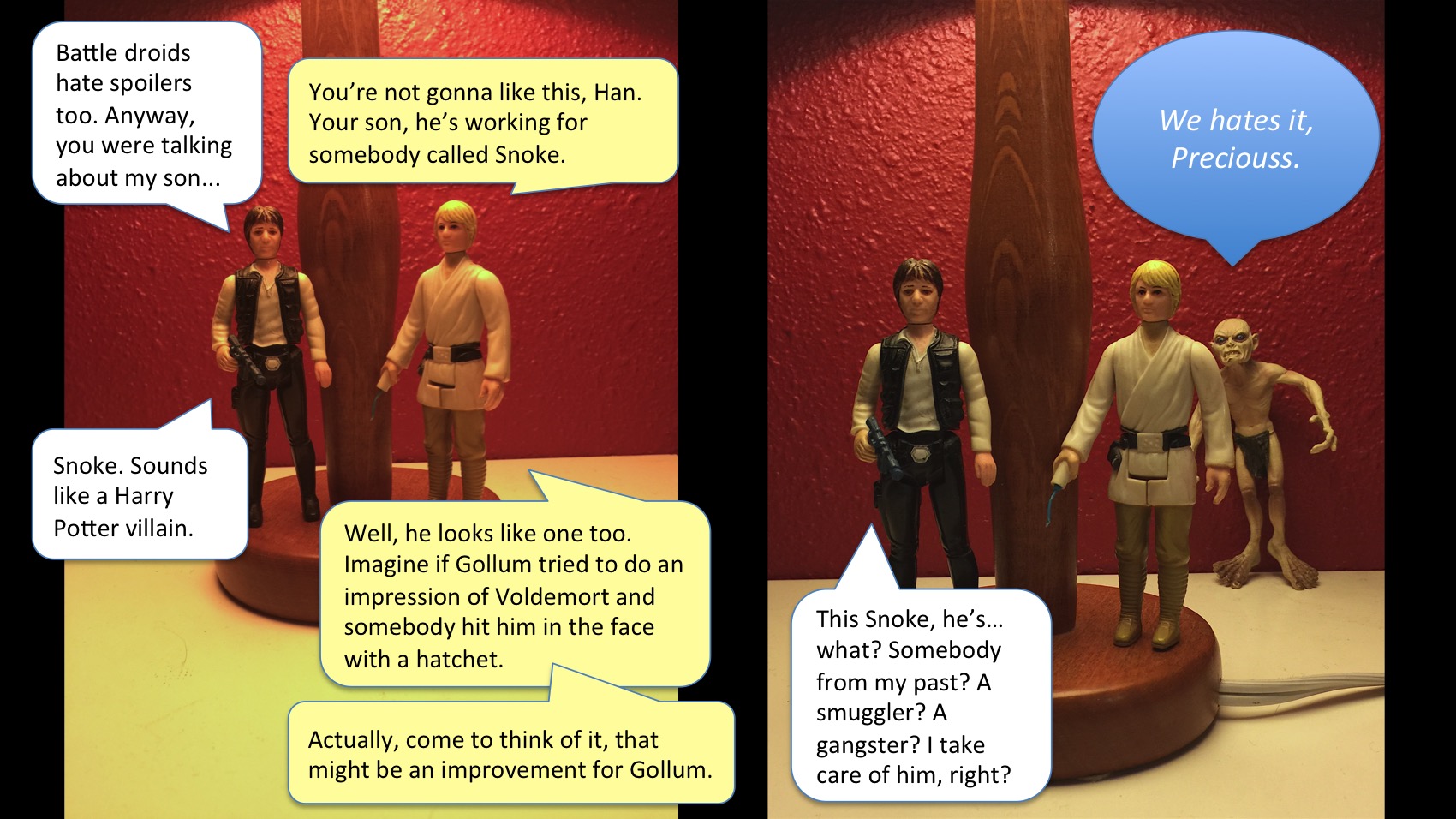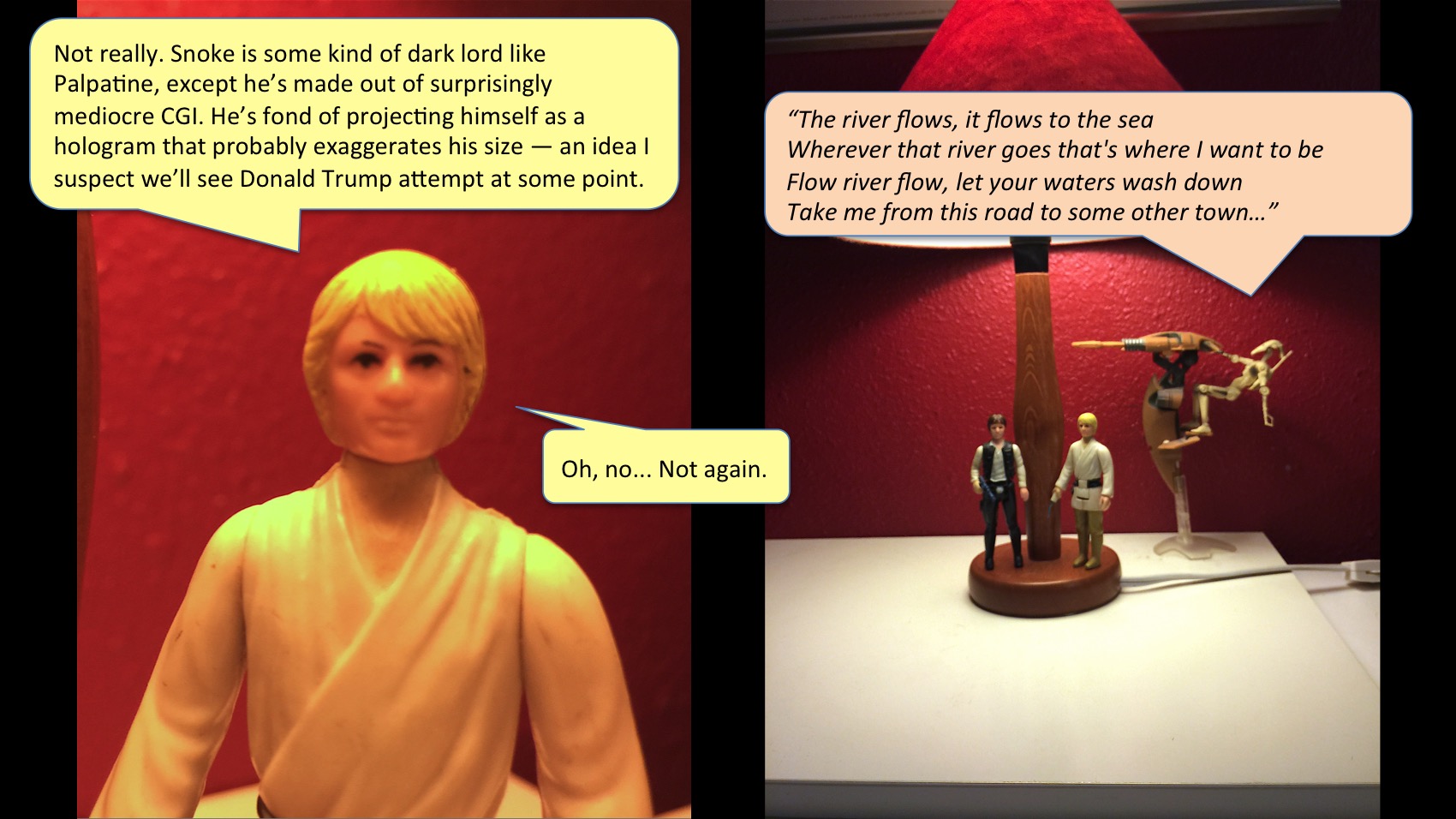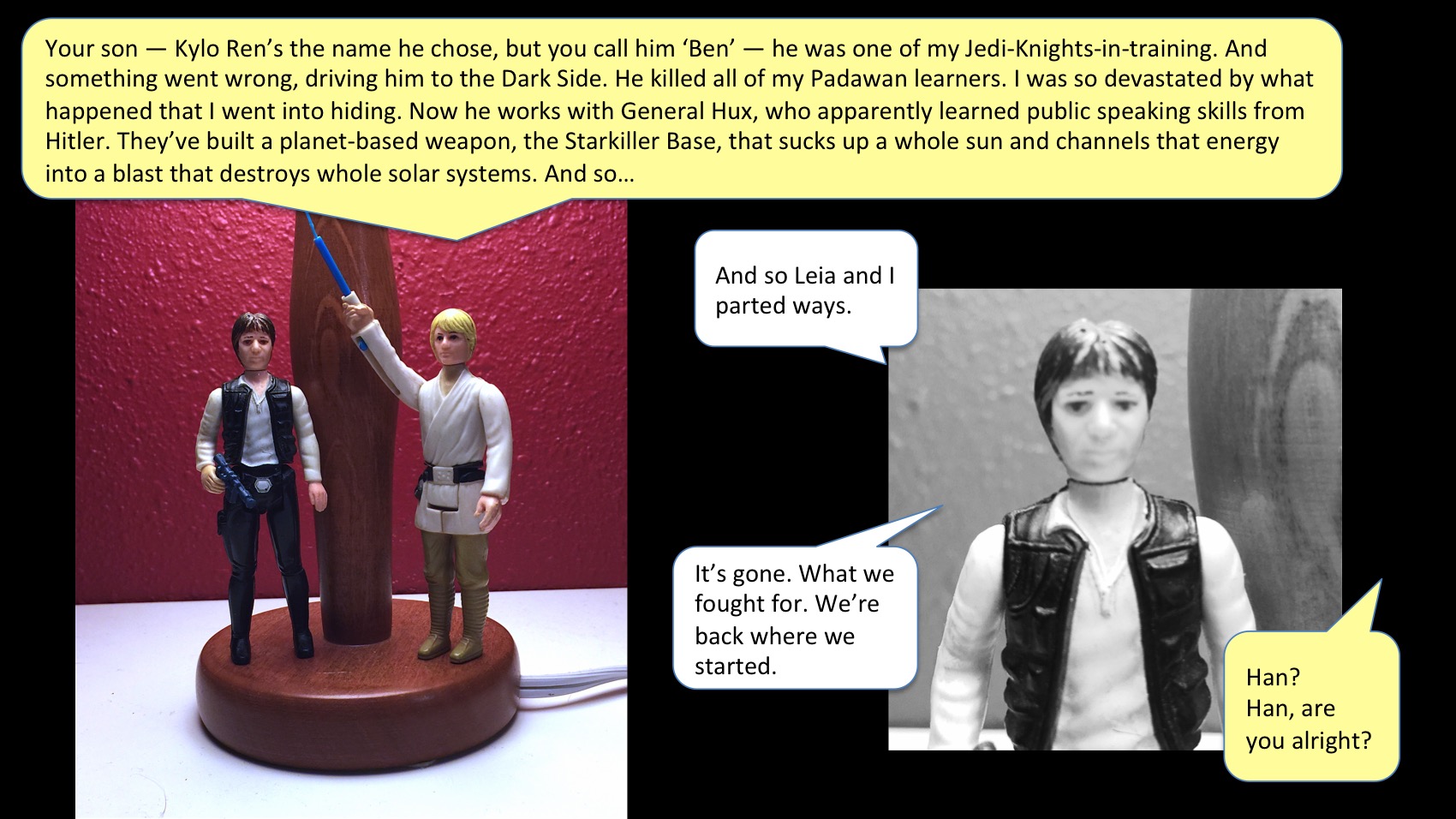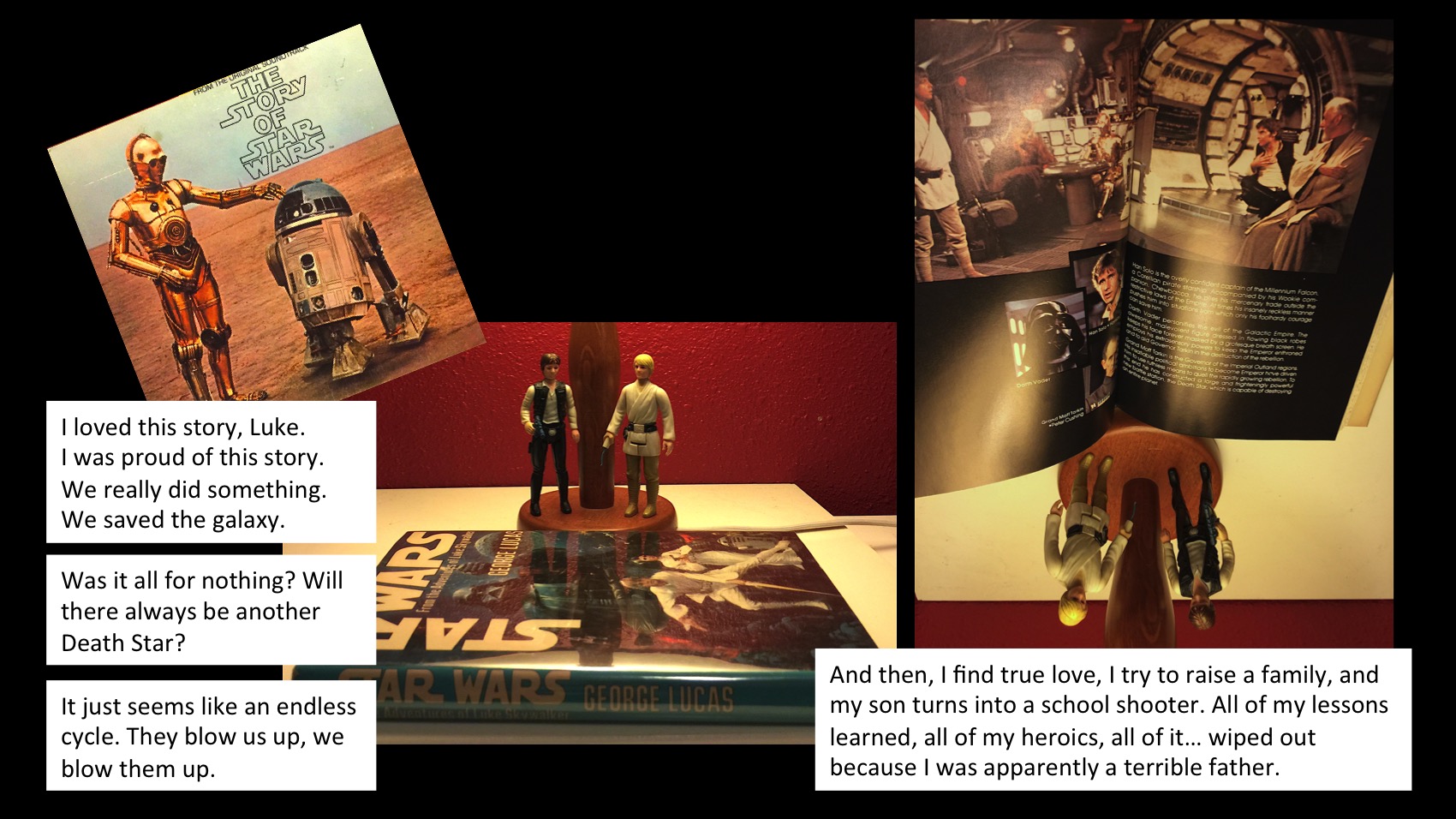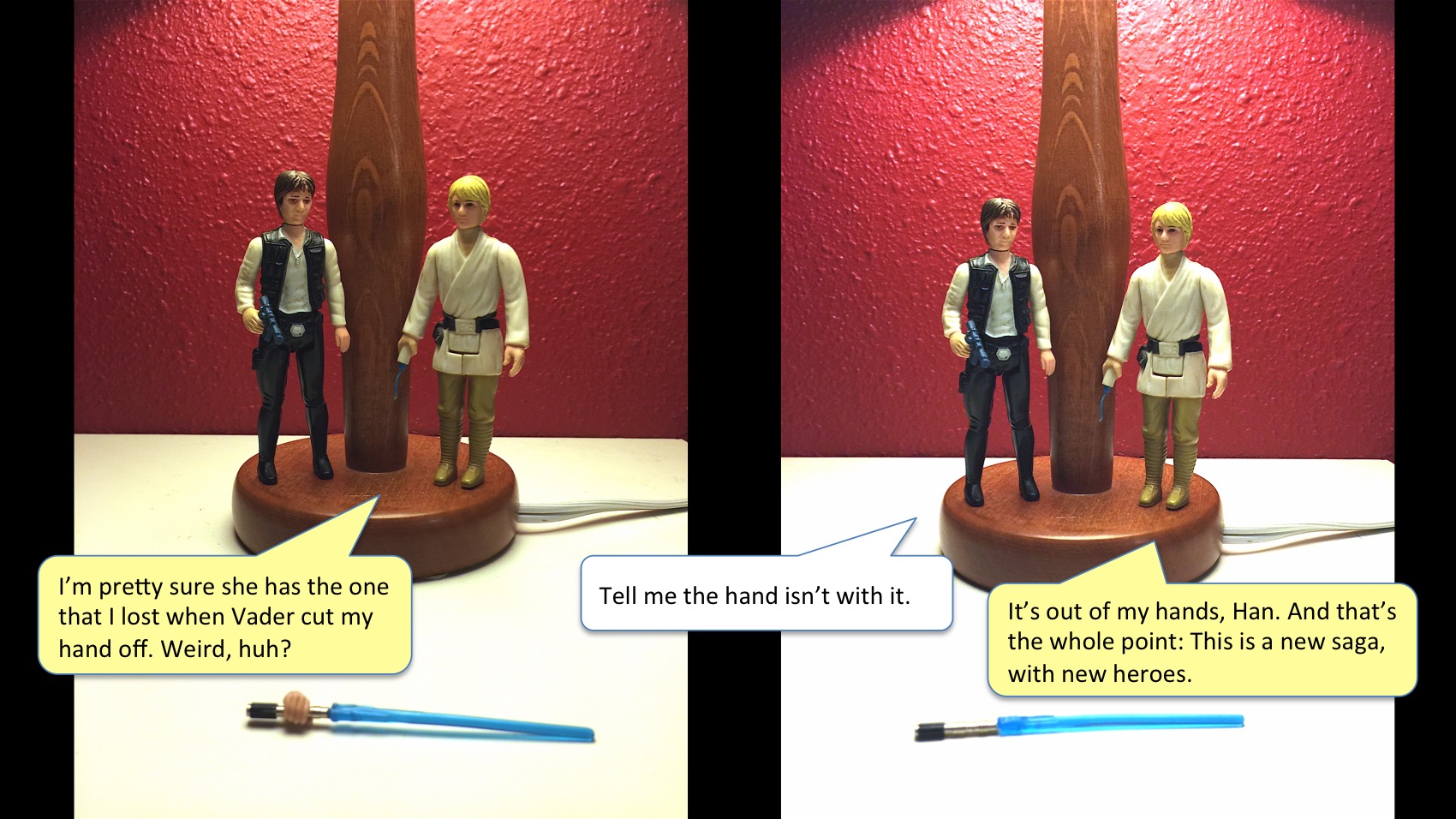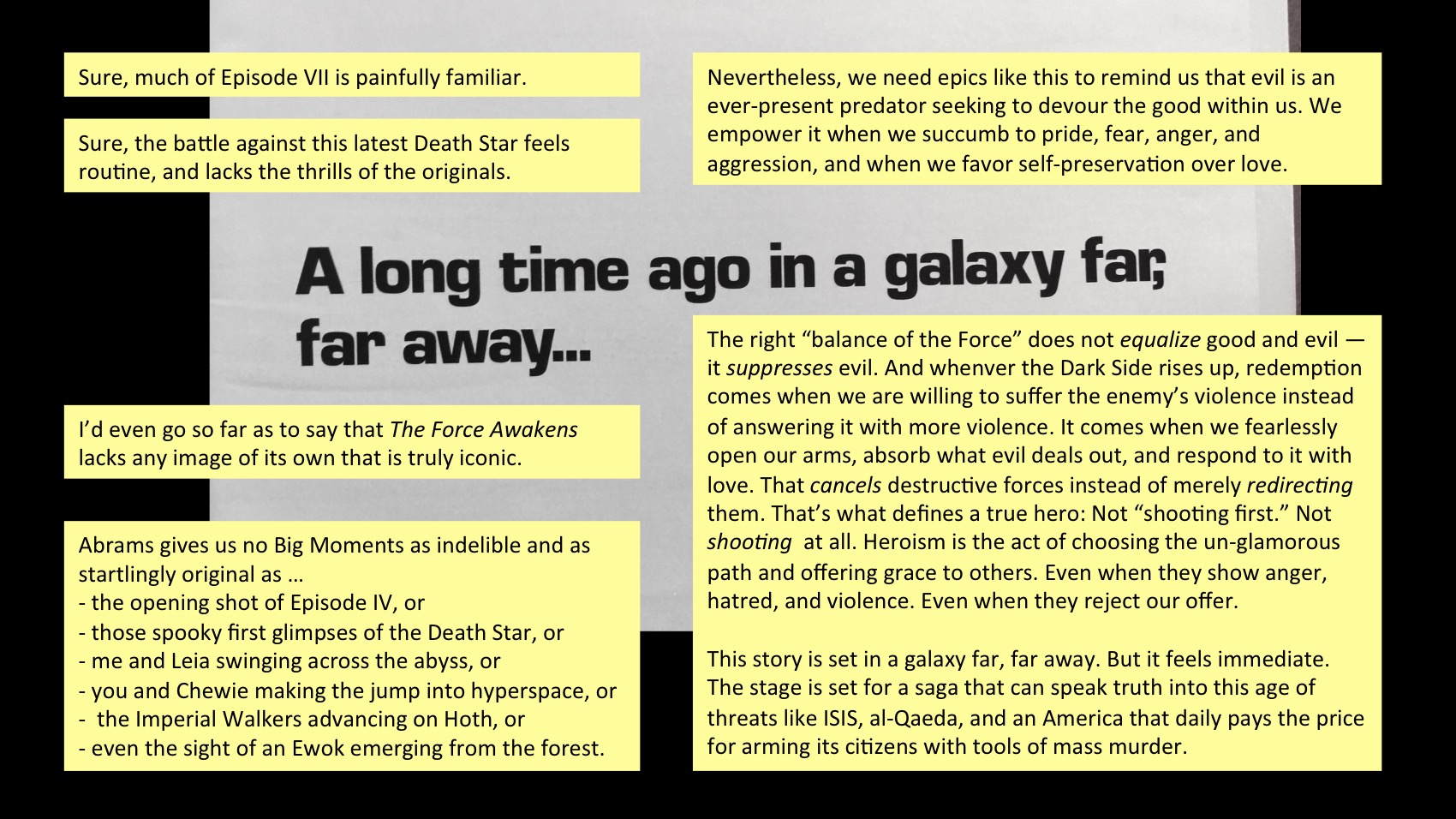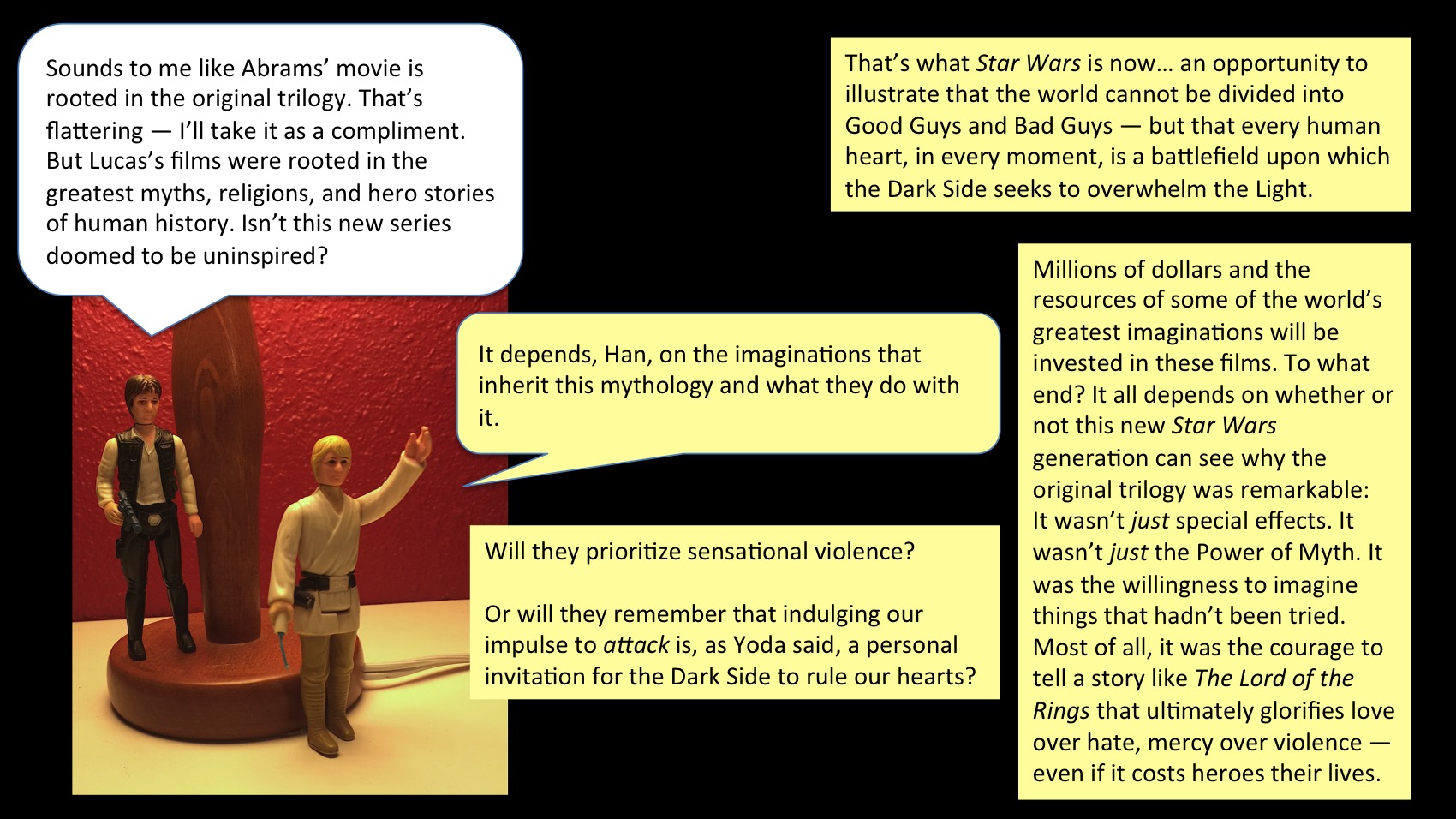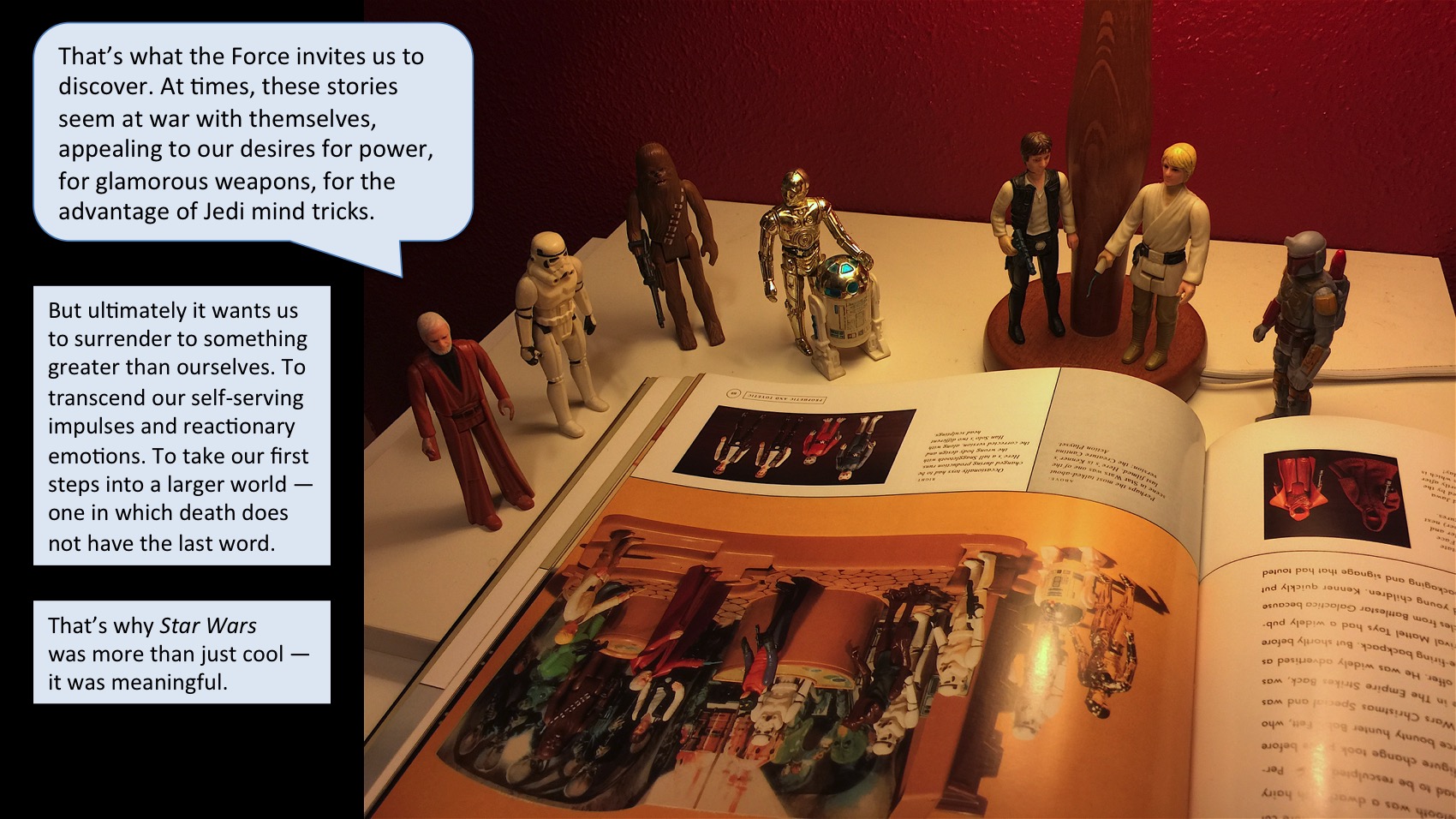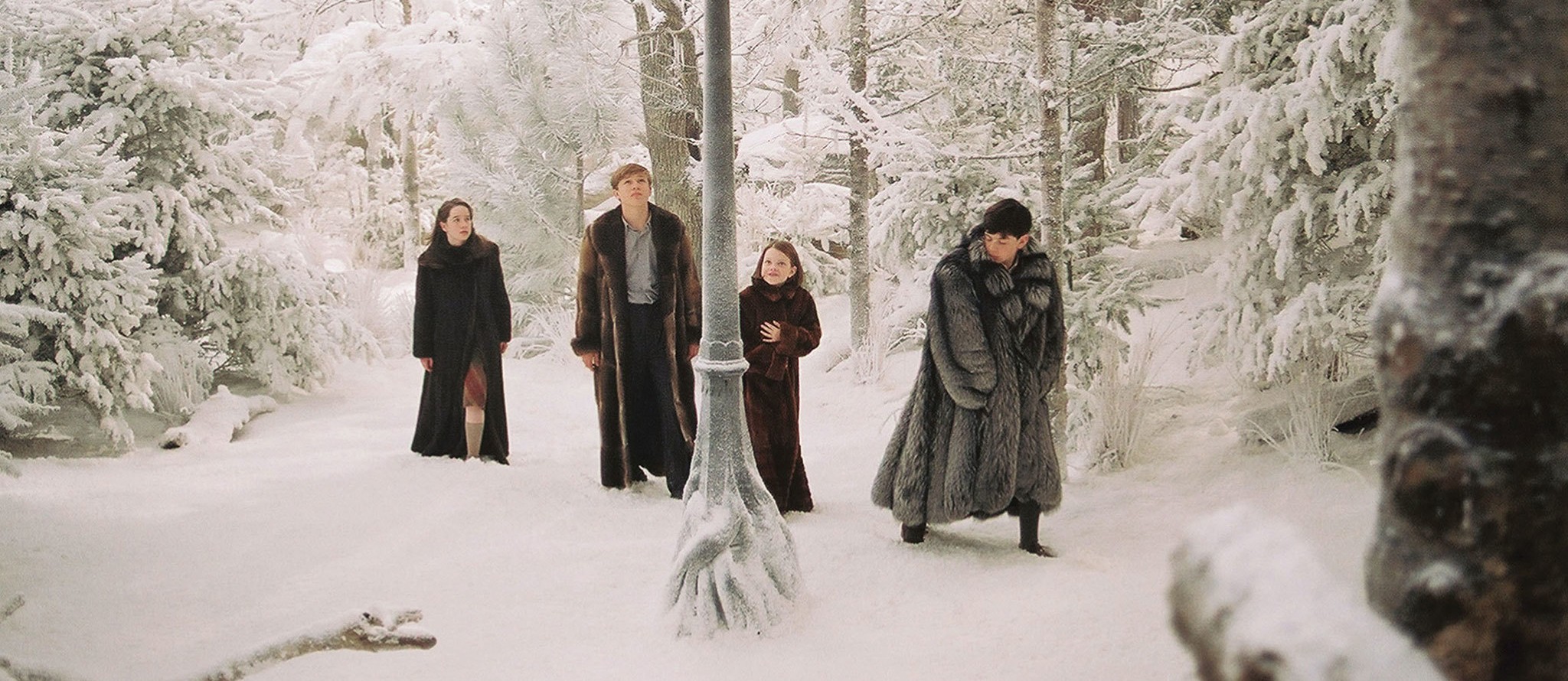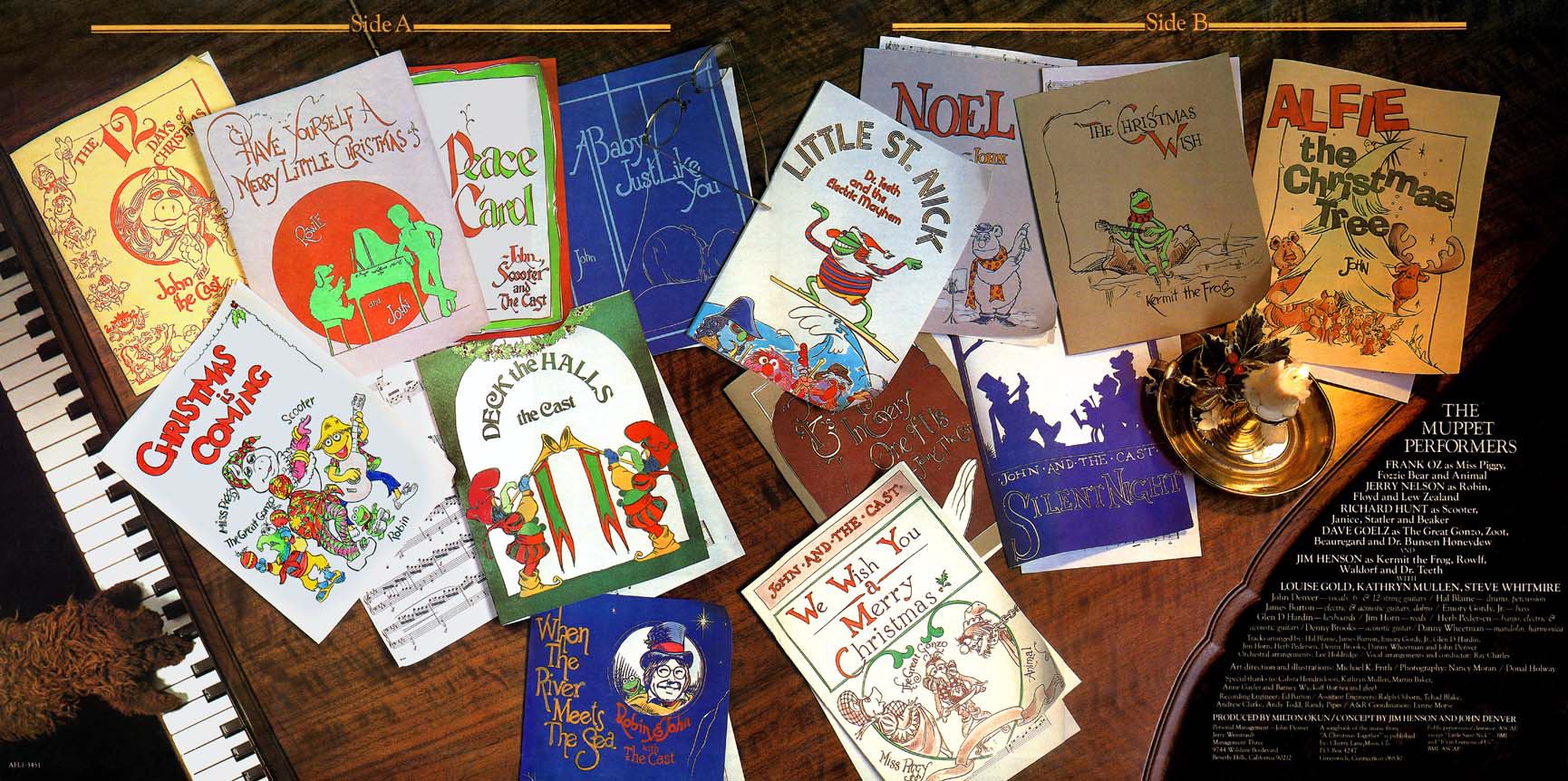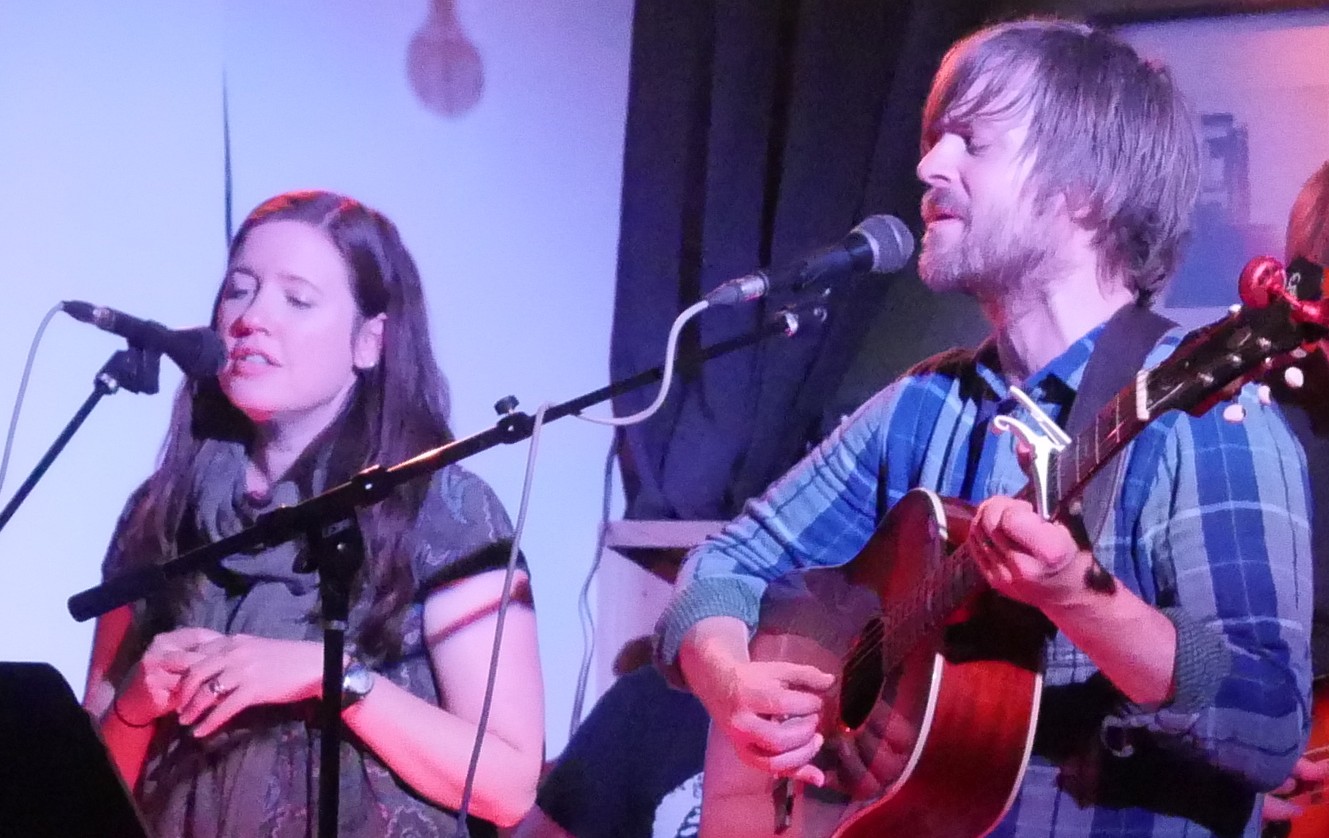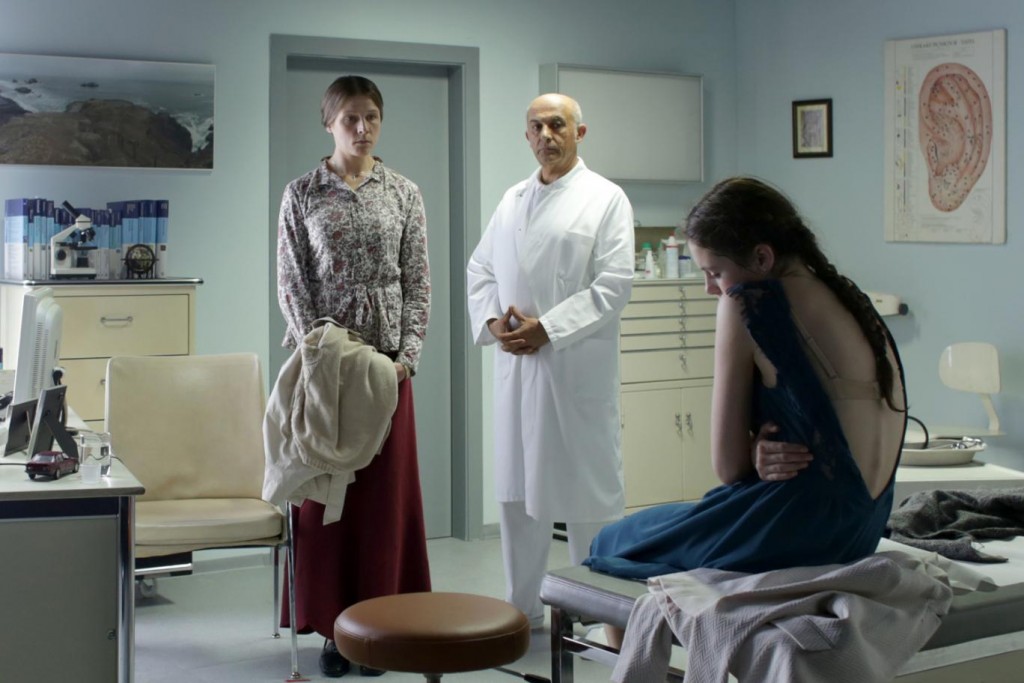Looking Closer's 2015 Playlist
Over the last several weeks, I've been building a playlist of some of my favorite songs from 2015. I'm wrapping it up between now and New Year's Eve. It's currently 64 songs long.
I've been sharing that playlist with the Looking Closer Specialists over the last several weeks, and they'll have access to the 2016 list all through next year as I build it.
But now's the time to raise the curtain for everybody. If you feel like treasure hunting for music you missed this year, maybe you'll find some treasure here. And if you feel like sharing your own favorite tracks, feel free to post them in the Comments below so I can keep on treasure hunting.
Also: No, this does not take the place of my annual favorite albums list. I hope to have that published for you on New Year's Eve.
I've been making late-December lists as a way of wrapping up the year ever since I was 13 years old. Making that year-end mixtape was a ritual as meaningful to me as wrapping presents for my family. One of the things I love about living in that boy's future is this: Now I get to share it with anyone who's interested. It's a small, small group, to be sure. But it gives me so much joy.
Bret Lott and the Ambition contest winners
It's Christmas Eve. I feel like handing out some gifts.
A few weeks ago, I invited people to send me their lists of films, books, or songs that speak to them about ambition. Then I asked a jury of Looking Closer Specialists to vote on the lists they found to be most inspired and interesting. I concealed the names in case they knew any of the players.
The vote is in. And the ambitious imaginations that produced the top five most popular lists will receive copies of the new book by The Chrysostom Society: Ambition, edited by Luci Shaw and Jeanne Murray Walker, and featuring an introduction by Scott Cairns.
Before I name the winners at the end of this post, I have a gift for everybody: a conversation with one of the writers who contributed to this book.
 I corresponded recently with my friend Bret Lott, the bestselling author of fourteen books, including Before We Get Started, The Hunt Club, Letters and Life: On Being a Writer, On Being a Christian. He is currently the nonfiction editor for Crazyhorse. His account of writing the novel Jewel — which led him all the way to an appearance on Oprah — is one of Ambition's many memorable chapters.
I corresponded recently with my friend Bret Lott, the bestselling author of fourteen books, including Before We Get Started, The Hunt Club, Letters and Life: On Being a Writer, On Being a Christian. He is currently the nonfiction editor for Crazyhorse. His account of writing the novel Jewel — which led him all the way to an appearance on Oprah — is one of Ambition's many memorable chapters.
I asked Bret several questions about Ambition and its challenging themes.
•
Overstreet: To whom would you recommend this book? Is it primarily for writers?
Lott: I’d say it’s for artists at large — ambition, in this day and age of Everyone Is a Superhero, gets a bum rap, as though it means stepping on the throat of someone else to get what you want. But an artist needs a kind of ambition in order to find the truest and best iteration of the work at hand, of the art itself; an artist also needs ambition to see to it that work gets the best venue, as it were, available. Artists have to be ambitious. And there’s nobody’s neck to stand on but your own.
Overstreet: How has your sense of ambition changed from the days before your first publication to now? Do you feel more or less ambitious?
Lott: I feel more ambitious than ever, but right alongside that ambition is the sense, because of how long I’ve been at this, of how hard it is to actually do this writing thing. I know more than ever my limitations, what I can’t do, but what I can’t do is what I want to do (I’m hearing Paul in Romans somewhere in here!), so it will be a matter of my ambition serving as the fuel I’ll need to attain that which I can’t right now.
One of my favorite quotes of all time, from John Berryman: “You should always be trying to write a poem you are unable to write, a poem you lack the technique, the language, the courage to achieve. Otherwise, you’re merely repeating yourself, going nowhere because that’s always easiest.” That's ambition, and the only thing that will sustain you as a writer who continues to make art.
Overstreet: If you could write to your younger, pre-publication self about your ambitions, what would you want to communicate to that version of you? What do you wish you’d understood earlier?
Lott: It’s going to be a long haul. Gird your loins. This will be a path fraught with discouragement and a lack of vocabulary and moments — many of them — when you will fail. I’m just sayin’.
Overstreet: This is a time of megachurches, celebrity pastors, big-budget “Christian movies,” and controversial fusions of religion and politics. If you could draw our attention to one aspect of the Scriptures that could speak wisdom about ambition into this present cultural cacophony, what would that be?
Lott: Micah 6:8:
He has told you, O man, what is good;
And what does the Lord require of you
But to do justice, to love kindness,
And to walk humbly with your God?
Overstreet: Tell us about a specific ambition you’d still like to achieve.
Lott: I want to write a good sci-fi novel. Not one about the gizmos of the future, but one about real people with real concerns, who live in a future (with gizmos) I can’t yet see but which I hope to glimpse.
Overstreet: Do you have a particular role model when it comes to ambition?
Lott: Raymond Carver and Flannery O’Connor.
Carver wrote out of and through his own alcoholism, coming out the other side with a greater sense than ever before of both the fragility and the resilience of the human spirit. He was a writer when he was in the throes of alcoholism, but was an even better one afterward, when he could look back and, with empathy and conviction, write about what matters most: love.
O’Connor wrote most of her best work when she knew full well she was dying, and her ambition to write and to write well even in the face of her imminent death serves to this day as an example of how to finish well as an artist.
Overstreet: What are you most pleased about with this finished book?
Lott: The quality both of production and content. That sounds cliché, I know — hey, it looks good and reads well! But I place a great deal of value on how a book feels in my hand, its production value, its beauty. Nothing like a crummily printed book to turn me off, no matter the quality of its words. This one delivers on both fronts.
Overstreet: Is there a complementary book you’d recommend that readers pick up for further reading on this subject?
Lott: John Gardner’s On Becoming a Novelist might be the one I would suggest — though I think anyone who wants to make art ought to read this. The book isn’t about how to be a writer so much as it’s a compendium of who the writer is, a portrait of the mind necessary to accomplish writing a novel. In it there’s a line I quote a lot to let students know that this is all about risking things — about being risky, about trying what you cannot yet do. He writes, “A writer’s successes bring him more than praise, publication, or money: they also help him toward confidence. With each success, writers, like stunt riders and ballet dancers, learn to dare more.”
There’s also Richard Hugo’s The Triggering Town, in which he writes, “To write a poem you must have a streak of arrogance . . . . By arrogance I mean that when you are writing you must assume that the next thing you put down belongs not for reasons of logic, good sense, or narrative development, but because you put it there.” This is a terrific book for poets — and artists — who are making their way into the world of art.
•
With those thoughts on our minds, let's turn now to some possible programming on the subject of ambition.
The winners of Looking Closer's Ambition Contest, who will receive copies of Ambition to read in the new year, are...
GOLD MEDAL WINNER ANDY DeBRUHL
...who recommended a three-movie marathon: 8 1/2, All About Eve, and Citizen Kane.
DeBruhl also had another film list place in the top 5: Whiplash, Black Swan, and Walk the Line. But we're limiting the players to one prize, so for this second list he just earns extra bragging rights.
SILVER MEDAL WINNER BRET ROOKS
...who recommended a three-volume reading list: Jayber Crow, by Wendell Berry; My Name is Asher Lev, by Chaim Potok; and The Red and the Black, by Stendahl.
BRONZE MEDAL WINNERS MARTIN STILLION, MATT ORTH, and JON CROFT
Stillion recommended movies: Citizen Kane, Julius Caesar, and The Peanuts Movie.
Orth made a playlist: “Fast Car,” by Tracy Chapman; “The Boxer,” by Simon and Garfunkel; and “Songwriter,” by Bill Mallonee.
Croft also made a playlist: “Opportunities (Let’s Make Lots of Money),” by Pet Shop Boys; “Over the Rainbow,” by Julie Garland; “The Impossible Dream,” by Andy Williams.
I'll be asking them for mailing addresses so that I can send them this brand new book that will help them manage their own ambitions. I mean, I certainly wouldn't want winning a contest to go to their heads and give them delusions of grandeur!
Thanks to all of you who sent in your lists. It was tough to pick winners.
Here's an ambition for all of you: Have a merry Christmas!
https://www.youtube.com/watch?v=n2MaqrQyq9U
The Chronicles of Narnia: The Lion, the Witch and Wardrobe (2005)
This review was originally published at Christianity Today in December 2005.
And ten years later, it pains me to look back and see just how much promise there seemed to be in this adaptation. It was going to happen: We were going to watch the Narnia series unfold on the big screen with a cast of accomplished actors, a crew of talented artists and craftsman, and all the power of Disney to make it work!
Alas, that didn't happen.
The first film gave us some of the iconic moments that those who love C.S. Lewis's children's stories had longed to see. But it had problems — including a desire to mimic the epic battle scenes of Peter Jackson's overblown Tolkien adaptations.
Then came Prince Caspian, which had more serious problems, and finally Voyage of the Dawn Treader, which, while arguably the most entertaining of the films, was also the one that strayed farthest from the source material.
Occasionally, we hear reports that the next episode is being prepared, but at this point I suspect that there are plenty of Lewis's fans who would be happier if Disney just left well enough alone.
Anyway, here's one from the archives...
•
My Original Christianity Today Review
At last, the Pevensies have reached the silver screen. What a joy to see Peter, Susan, Edmund, and Lucy — the four siblings of C. S. Lewis's beloved The Lion, The Witch and The Wardrobe — brought to life so vividly. After all of the rumors, the fretting about literary fidelity, and the angst about religious agendas, we can praise director Andrew Adamson and his fine young actors for developing these "Sons of Adam" and "Daughters of Eve" into three-dimensional, engaging characters.
There they stand, at a train stop in the middle of nowhere, luggage in hand, fidgety and nervous. Their mother has sent them away from bomb-blasted London due to the Nazi threat, and they're on their way to a safer place in the country. Wasn't someone from the mansion of Professor Kirke supposed to meet them here and take them away to their new wartime refuge?
But they're no more nervous than Lewis's countless fans who worried about a faithful adaptation. Could Adamson pull it off? Would the film measure up to the hype and expectations? Are these Pevensies like the children of the book? And above all—did they get Aslan right?
Indeed. Many mainstream journalists have treated the movie as a sort of pending terrorist attack, but this movie cannot be dismissed, like so many preachy "Christian films," as religious propaganda. And the anxious faithful can relax, as Adamson has done no serious injury to the narrative's basic outline of sacrifice and redemption. "The lion's share" of Lewis's meaningful story remains intact.
Adamson, who also directed the Shrek films, was never much interested in the religious implications of Lewis's narrative. He, like Lewis, was caught up in the wild imagination of a timeless fairy tale, which happens to be full of references to the pagan mythology that Lewis found so rich with reflections of the truth. The film, which was made under the watchful eye of Lewis's stepson Douglas Gresham, is best enjoyed as a symphonic and delightful fantasy. It's a kaleidoscopic vision of fanciful and colorful creatures, fantastic landscapes, and laugh-out-loud surprises.
Into the Wardrobe
The film literally opens with a bang, as Adamson smartly starts by depicting the German air raids on London. In that chaos, Adamson establishes the Pevensies' four distinct personalities and temperaments in quick, efficient strokes, even before the train carries them out of London.
What happens next is one of the most enchanting sequences in the history of fantasy filmmaking. For a few minutes, everything is exactly as it should be. Mothballs. Fur coats. Snow crunching underfoot. Prickly needles of evergreen. This chapter is lifted beautifully from Lewis's description, ushering us into his wonderland with exquisite grace.
Here, young Georgie Henley, playing the role of Lucy, reveals that she's the film's greatest treasure. If eyes are windows to the soul, Henley's soul is super-sized. Without her vibrant personality and mischievous grin, Narnia would lose its lifeblood. She makes Lucy's awe and delight contagious. (Her glee is quite real: In a stroke of genius, Adamson arranged for Henley to be carried onto the dazzling wintry set blindfolded, and the cameras caught her actual response to its beauty.)
Lucy, still wide-eyed with wonder, then meets Mr. Tumnus the faun, played by James McAvoy. In an endearing turn, McAvoy gives the faun delicate humor and a haunted heart, and his interaction with Lucy is both charming and portentous.
Adamson gives each child a clear and separate journey. Lucy will lead them, as fairy-tale children so often do, into a world of discovery, and her faith will be richly blessed. Susan (Anna Popplewell) will learn that logic and "too much thinking" can prevent her from apprehending miracles. Peter (William Moseley) is insecure and easily exasperated, whereas in the book he was a natural leader; like Peter Jackson's melancholic Aragorn in the Lord of the Rings trilogy, he must rise to seize a sword and lead the charge against evil.
Above all, rebellious Edmund (Skandar Keynes) benefits from the revisions. The boy's obstinacy now seems to spring from a reasonable source—he's distraught over his father's wartime absence. His attempts to discredit Lucy's discovery of Narnia are given new motivation and vitality, and his betrayal of his siblings stings, swells, and aches for most of the film.
Turkish Delight, of course, baits Edmund to his fall, served up by the magisterial tempter of this frozen wonderland, the White Witch. Tilda Swinton plays the Witch with admirable restraint and intelligence. In spite of her outrageous costumes and an annoying dwarf attendant who desperately needs a throat lozenge, she's an effective seductress—it's believable that a naïve troublemaker would accept her cold comfort. Like Palpatine delivering sugar-coated lies to Anakin Skywalker, the Witch fools him with what he can't get elsewhere: flattery and promises of power.
A Mere Amusement Park?
It's odd, however, the way that Edmund gets from place to place. In the novel, he makes a torturous journey to reach the Witch's castle. But here, Narnia's landmarks feel about as far apart as Disneyland's amusement park rides. The castle's just a couple of city blocks from the beaver dam, which is a quick stroll from the lamppost, which is just around the corner from the hills where Aslan's entourage awaits.
But there are deeper problems here. Insofar as the movie adheres to Lewis's text, it's a knockout. But as Adamson wedges in original action sequences, he willingly sacrifices far too much of Lewis's most essential dialogue. Peter Jackson had no choice but to severely abbreviate The Lord of the Rings in order to contain it in feature-length chapters, but Adamson's challenge was quite the opposite. Lewis's story is short, simple and concentrated—every episode, every line counts.
For no good reason, conventional adventure spectacle replaces the joys of long, memorable sequences like the melting of the witch's dominion, a woodland Christmas party, and the thawing of prisoners. Adamson's more excited about inventing a frantic fight with wolves on a frozen river, and 20 minutes of elaborate, Jackson-esque, CGI warfare, as if to ensure there's enough material for a video game tie-in. Lewis, preferring beauty to violence, only gave the war a page or two.
The beavers, vividly voiced by Ray Winstone and Dawn French, are a cartoonish but likeable pair. But they're robbed of significant lines that build our apprehension of meeting Aslan and help us understand his kingship. The book's devotees will be dismayed to find that Mr. Beaver is denied his famous speech about Aslan's power and authority: "Who said anything about safe? 'Course he isn't safe. But he's good. He's the King, I tell you." (Tumnus and Lucy echo this sentiment later, but it doesn't serve the same purpose.)
Meanwhile, our dear, benevolent Professor has been reduced almost to a bit role, with many of his key lines of dialogues seriously abbreviated or outright dropped. It staggers the imagination as to why he's been minimized to just a couple of grandfatherly interjections. An expanded "special edition" is in order.
A Diminished Aslan
As for the character we've all longed to see — Aslan — let's face it: He's not the Aslan who gave that novel its bold and beating heart. He's given a voice of nobility and gentleness by Hollywood's favorite warrior-mentor, Liam Neeson. Thanks to the animators, he's a beautiful sight, if not quite as convincing as the CGI characters in Jackson's Middle-Earth. But Adamson, working with Emmy-winning co-writers Ann Peacock, Christopher Markus, and Stephen McFeely, has severely altered Aslan's presence and power in the script.
While other characters' roles have been expanded, the lion's appearances are painfully brief. He doesn't have the time onscreen to earn our affection and awe the way we might have hoped. And scene by scene, the writers consistently skirt the issue of Aslan's authority, eliminating most references to his history, power, and influence. Aslan's father, the Emperor-beyond-the-sea, is never mentioned. Instead, the lion waxes philosophical like Obi-Wan Kenobi, mentioning the Deep Magic that "governs" his "destiny." Huh?
Just as Aslan's majesty has been diminished, the strength of the Witch has been upgraded. She bears little resemblance to the sorceress who made Mr. Beaver declare, "If she can stand on her two feet and look [Aslan] him in the face it'll be the most she can do and more than I expect." In the novel, Jadis went into terrified hysterics at the mere mention of Aslan's name—here she barely flinches. When they face off, she's fearless. Did Adamson make the White Witch a more threatening villain to increase suspense? That's a practical idea. But Lewis would have objected. This Aslan is essentially muzzled and bound long before the Stone Table scene.
Still a Success
It is a shame to have lost any of Wardrobe's wonderful resonance. But in spite of some grave errors in judgment, Adamson's film is still an admirable success. Let's keep things in perspective: It was once rumored that other filmmakers were moving the story from London to present-day L.A. after an earthquake, casting Janet Jackson as Narnia's Witch, and packing Narnia's streets with wisecracking critters à la Madagascar. Adamson and company should be commended for respecting Lewis's imagination as much as they did.
Lewis described a story's sequence of events as "a net whereby to catch something else." While Aslan's intimidating power and glory has escaped them, the filmmakers have "caught" the essence of The Lion, The Witch and The Wardrobe. And they've blessed the holiday season with a first-class family film that will stand tall after Lewis's detractors have spent their feeble arrows.
With its story of a savior who suffered the consequences for others' sins, and whose power proved greater even than death, this meaningful myth reflects rays of hope into a culture paralyzed by the chill of unbelief, where many really would prefer a winter without a Christmas. Those who respond to the movie's roar by running to Lewis's book will find Deeper Magic in its pages. Meeting them there, Lewis himself will lead them "further up, further in."
Ken Priebe's Christmas Playlist
Stop animation — that's what I see when I hear "Rudolph the Red-Nosed Reindeer" or "Santa Claus is Comin' to Town." I suspect that this is true for many who grew up, like I did, with a Christmas tradition of watching stop-animation specials on TV, like the two that got their titles from those songs.
 So it seems right and good to invite animator, illustrator, author, and instructor Ken Priebe as a special contributor to the Looking Closer Christmas Playlist project.
So it seems right and good to invite animator, illustrator, author, and instructor Ken Priebe as a special contributor to the Looking Closer Christmas Playlist project.
Ken has written two books on the demanding art of stop animation. And he will soon share a new book with the world: Gnomes of the Cheese Forest.
These are the songs that serve as Ken's Christmas soundtrack.
•
John Denver and the Muppets: A Christmas Together
Christmas and the Muppets have always gone hand-in-hand for me. I had this album on vinyl growing up, and have since collected a rare CD print of it to keep returning to it year after year. In many ways I feel it's one of the best achievements of the Muppets in general, and the mix of songs really captures their essence from the peak of their popularity in the late 70s.
The music of the Muppets was very intentional in preserving and re-inventing classic songs of eras gone by, from vaudeville standards to jazz and old show tunes. Their Christmas album is no exception, as it brought to light traditional carols and gave them their own unique spin. Their version of "Silent Night" even includes a monologue by John Denver which explains the history of how the song was written, and then sings it with sacred grace and reverence to its original source.
While specifically religious themes were a rarity in most Muppet holiday specials, this Christmas album does bring a few to light. Another monologue by John in his original tale "Alfie the Christmas Tree" makes specific reference to the Son of God and puts it in the context of a plea to remember the trees and creatures of the natural world (a subject which was close to the heart of both John Denver and Jim Henson). The "Savior King" is also referenced in the beautiful song "A Baby Just Like You." All of this tradition mixes with the typical Muppet comedy, silliness, and banter in songs like "Christmas is Coming," "We Wish You a Merry Christmas," and even the Electric Mayhem's cover of "Little Saint Nick."
The highlight of beauty and mystery in the album culminates in "When the River Meets the Sea," a favorite Paul Williams song also used in the brilliant TV special Emmet Otter's Jugband Christmas, whose lyrics invoke images of nature, life, death, re-birth and a childlike faith.
I love John Denver’s voice too, and as far as I’m concerned, he was one of the Muppets himself.
https://www.youtube.com/watch?v=dPki7AqPAP4
Christmas Eve on Sesame Street
While on the subject of the Muppets, it’s hard for me to wax nostalgic on my childhood Christmas memories without referring to 1978’s TV special Christmas Eve on Sesame Street, which I also had as a soundtrack on vinyl.
The musical moments in this special sum up so much of the Christmas spirit for me growing up, from "True Blue Miracle" to "Keep Christmas With You," and especially Bert and Ernie’s coda to their storyline (a version of “Gift of the Magi” with Ernie’s Rubber Duckie and Bert’s paper clip collection), a duet of "Have Yourself a Merry Little Christmas." To this day, Jim Henson and Frank Oz’s cover of this song is the defining version for me, and one of their finest moments as performers.
https://www.youtube.com/watch?v=R1rOG-GiY64
A Charlie Brown Christmas - The Vince Guaraldi Trio
Another regular staple on my annual playlist, both for viewing and listening, is the full soundtrack to my #1 favorite Christmas special. The opening shot of snowflakes falling coupled with the first notes of “ChristmasTime is Here” is another one of those moments that not only takes me back to my childhood but one that I’ve carried forward year after year as a tradition that sums it all up, and now I got my own kids wrapped up in a love for Peanuts (and Muppets) along with me, and this wonderful music is all part of it.
https://www.youtube.com/watch?v=ewG5xsNz5No
"Jesus Christ the Apple Tree" - Bob Bennett
In more recent years I’ve discovered other meaningful Christmas tracks to play annually, along with all the warm fuzzy nostalgia from my childhood. Among these are the songs recorded by Bob Bennett off his Christmastide album, produced by my friend Roy Salmond. I was most fortunate to attend a Kindlings Hearth retreat with Roy and Bob, and once you hear Bob play guitar and sing live in front of you, your life is never quite the same. His beautiful voice has enriched many a Christmas for me since then.
Alongside one of his songs three years ago, my wife and I arranged to have children and adults from our church contribute to a special project. We gave each person a different ornament from the traditional “Jesse Tree” advent calendar and asked them to produce a piece of artwork that represented somehow the character, symbol, or concept behind each ornament. We put all the art we collected into this video presentation, set to Bob’s recording of "Jesus Christ the Apple Tree."
https://vimeo.com/55754297
'Better Days" - The Goo Goo Dolls
Going in a different direction, this is one of my absolute favorite Christmas songs. It’s made especially poignant when remembering that Christmas is not only a joyous time but can also be a difficult time for various reasons. Whether it be the absence of loved ones who have passed away, reminders of past grievances or just the stress, rush and commercialism of the season, the sky is darkest at this time of year for many... a paradox to the joy that is still there when the light shines in the darkness.
That being said, this song fills me with awe and wonder by pointing me to that light when the frustrations that Christmas can bring become all too evident at times. I love the lyrics, which remind me that at the heart of it all, “tonight’s the night the world begins again.”
https://www.youtube.com/watch?v=i-kHleNYIDc
"Blue Christmas" - Porky Pig
And from the sublime to the ridiculous, this track always finds its way to my Christmas playlist. It’s not by the actual Porky Pig (otherwise known as Mel Blanc)... it’s a novelty recording done by a New Jersey DJ and it makes me laugh each time I hear it. Not only because of the singer himself, but even more so because there is someone else cracking up in the background the whole time.
https://www.youtube.com/watch?v=pg7HvF3a_Iw
"Jingle Man Christmas Boy" - Steven Colbert
And on a final note of ridiculous-ness, I leave you with this, a little outtake from another annual Christmas special that’s become a quotable favorite in our household, which my wife and I like to enjoy after the kids are nestled all snug in their beds, while visions of sugar plums dance in their heads.
https://www.youtube.com/watch?v=QZWVOSfahiQ
Merry Christmas to All and to All a Good Night!
The Partains' Christmas Playlist
If you're having the kind of year that I'm having, you need to take Christmas music with you or the season will pass you by in a hurry. So I'm grateful for the Christmas playlists that friends have been sharing with Looking Closer. Dusty Henry's favorites are now a part of my Christmas soundtrack. And I keep going back to the long, long list of imaginative playlists that I collected last year.
For more than 15 years, Anne and I attended Green Lake Presbyterian Church in Seattle. For some of those years we were blessed, Sunday after Sunday, by the beauty of what musicians Nathan and Sarah Partain offered. They now serve at Redeemer Presbyterian Church in Indianapolis, where Nathan is director of worship and culture.
 But their musical reach goes far beyond the sanctuary of their church. Earlier this year, I turned to their latest album (which was recorded under the moniker Jaywalker) for comfort, hope, and healing as we were all wounded by the violence in Charleston. When I wrote about tragedy, I shared some of them: You can listen to Jaywalker here.
But their musical reach goes far beyond the sanctuary of their church. Earlier this year, I turned to their latest album (which was recorded under the moniker Jaywalker) for comfort, hope, and healing as we were all wounded by the violence in Charleston. When I wrote about tragedy, I shared some of them: You can listen to Jaywalker here.
I celebrated my birthday this year in Nashville, and one of the highlights was a rare opportunity to spend time with Partain family at the home of musician Kenny Meeks (Sarah's father). Our friendship is deeply rooted in our shared faith and our passion for music. So I'm not surprised that they responded to my questions about favorite Christmas music with a generous playlist full of inspiring stuff.
Here's what Sarah has written about their holiday soundtrack.
I've grown up listening to many different Christmas records. When we moved to Tennessee in 1986, Amy Grant's "Tender Tennessee Christmas" became a staple around the house, as we missed the snow of Michigan yet tried to feel comfortable in our new southern home. Elvis Presley's "Blue Christmas" and George Winston's "December" were in regular rotation, especially if it snowed! And I've always loved the music of "The Nutcracker" and "A Charlie Brown Christmas" even from an early age.
The past few years, my Christmas playlist has been about the same with some additions here and there. This year, the old favorites are there as well as some new discoveries.
1) O Tannenbaum — Vince Guaraldi Trio
I love this song and soundtrack so much. Every time I hear those first few notes of the piano, I immediately get excited about what's about to happen. There is a warmth and creativity about it that's rich and inviting. For music for a children's show, it's incredibly complex and musical, something we rarely find today. I heartily agree with Linford Detweiler who said it is the greatest Christmas record of all time!
https://www.youtube.com/watch?v=_fh133ZO1AE
2) Glory to God in the Highest — Nathan Partain: Listen here.
This is a recent addition to my favorites. Its rich short story-like verses that end in a pinnacle of Christ's birth, weave together stories throughout time and is a reminder of what Advent and Christmas are about.
3) Bethlehem's Stable — Kenny Meeks
This is a song that my dad wrote in 2006 as a submission to Grassroots Music in Huston, TX. I love the simple recording that has a cool bluesy richness and great story telling that draws you in to the vulnerable story of Mary and Joseph welcoming Jesus into the stable.
https://www.youtube.com/watch?v=yS6uUqeu5BQ
4) O Come O Come, Emmanuel — Sixpence None the Richer
I love this beautiful version of this song, with soft singing and an interesting twist to the arrangement.
https://www.youtube.com/watch?v=AfDK4I8CKfE
5) The Spirit of Christmas — Ray Charles
Last year, I noticed this song in one of the scenes of "National Lampoon's Christmas Vacation", and soon started listening to the whole record by the same name. It has a great vibe and groove, as does the whole album. Charles' versions of "Little Drummer Boy" and "Rudolph" also have a bluesy funk to it that is great for an impromptu Christmas kitchen dance party!
https://www.youtube.com/watch?v=EaAdg_l38Cc
6) Rain for Roots — Waiting Songs: Listen here.
This is Rain for Roots' third album and it's only been out for a few weeks. The songs are geared toward kids, with easy words and melodies to sing along with, but again, have such a richness and depth in content and music that adults will appreciate. Their records always quickly become a family favorite and this one is no different!
7) Come Lord and Tarry Not — Music from the worship team at Green Lake Presbyterian Church, circa 2004
Our time at Green Lake Presbyterian Church was one of great spiritual growth and discovery. One of the things that was vital to worship there was that the songs were written for that specific body of believers for a specific time and place. It was also the first time we began to explore singing songs other than straight Christmas carols on Sunday mornings and focused more on Advent-centric music. Nathan re-wrote the music to this song and the whole worship team got together one Saturday to do a big live recording of the top 5 non-traditional Christmas songs in our church at that time. This song is my favorite one that came from that recording session.
8) Come Thou Fount — Sufjan Stevens
I admit that I am not a huge fan of Sufjan Stevens but I do like his Christmas music and feel that he does it well. This version is so simple yet lovely and I love thinking about this song as an Advent song, too.
https://www.youtube.com/watch?v=O8q3hXXM9mk
9) White Christmas — Bing Crosby
There's something about this classic record that is so enjoyable and festive to listen to, and I like to put it on while decorating the tree or baking Christmas cookies!
https://www.youtube.com/watch?v=GJSUT8Inl14
10) Silent Night — Low
This is another new discovery and again, really enjoy the warm and simple production and performances. This version is beautiful and peaceful and reminds me of the end of a candle-lit service every time.
https://www.youtube.com/watch?v=QOZwvRzPvz8
11) White Winter Hymnal — Fleet Foxes
A friend of mine once posted on Facebook that one could listen to Fleet Foxes in any season of the year and it would somehow be perfect. I totally agree! This song in particular feels like a festive antique Christmas card or movie, with its rich lyrical imagery and haunting melodies.
https://www.youtube.com/watch?v=gml-nAJGRbY
12) Christmas (Baby Please Come Home) — U2
From one of my favorites comes a soulful song that's a refreshing break from the sugar holiday pop tunes. I also like that little touch of heartache that's being felt and the yearning for one's loved one to return.
https://www.youtube.com/watch?v=ebiVOt-gqa0
13) It's Christmastime, Again — Tom Petty
The first time I heard this was during my first Christmas season working retail. It was on the Christmas soundtrack that we played over and over in the store. Again, it was a welcome and fun change up from the run-of-the-mill cheesy Christmas songs!
https://www.youtube.com/watch?v=vzKNzKuYEVo
Stations of the Cross (2015)
"Do you think it would be a good idea if Michael Haneke made a film based on a concept by Lars von Trier?"
So writes Michael Sicinski, one of my most reliable sources of discernment and insight on cinema, on Dietrich Brüggemann's Stations of the Cross.
And I can see his point: Like so many of Haneke's films, Stations casts us into an hermetically sealed hell, and its impressive long-take scenes turn up the tension to "11." And, like so many of Von Trier's films, everything is framed to amplify our sense of the tortures suffered by the central female figure. This whole thing is rigged to make traditionalist Catholic fundamentalism look like a death trap, so that in each scene an icon of innocence and vulnerability is suffocated by the constricting python of the legalistic religiosity in which she is being indoctrinated by her tyrannical Nosferatu of a mother. So yes, there is something extreme and merciless about this script.
Other critics have faulted this film for being preachy and sanctimonious in its attack on religion.
But here's the thing:
I grew up in a very strict Christian community that preached the satanic influence of secular music's rhythms; instilled terror in young people over the ways in which hand-holding, short skirts, and dancing could lead to wild sexual abandon; and warned me of the dangers of fraternizing with unbelievers. These were Protestant forms of the same extremism manifested by the Society of St. Pius X here. But all of the pressures applied to poor Maria in this film feel familiar and real to me. My family found a way to embrace Christian faith within that community without adopting the aggressive "condemn the world" stance that many of our fundamentalist neighbors held. But I saw children suffering from the same kinds of extreme tyranny we see here.
The performances ring true to me, even if they are pushed all the way to the edge of parody. Lea van Acken seems born to this play this part: Maria reminds me of more than one girl I knew in school. I remember seeing them strain to distance themselves from more "worldly" girls in our private religious school, and ultimately hating themselves for wishing that they could the freedoms and pleasures that "reckless" girls enjoyed. (Boys had versions of the same conflict, of course; but our patriarchal culture wasn't as inclined to hold them accountable or punish them.)
While the character of Maria's mother is depicted as a black hole sucking light and life from her children and then intimidating and bullying those around her (her husband moves like a traumatized resident of a concentration camp), I can testify that I've met people just like her. (Franziska Weisz's performance is effectively terrifying.)
To be honest, I understand her a little too well. I have some experience in drawing stark lines around my own ideas as good and others ideas as evil. As an early teen, I was quick to embrace conservative Christian legalism myself so that I could enjoy the unhealthy but exhilarating energy of exalting my own perceived "rightness" and "goodness" by vigorously condemning anything that offended my strict code. It was a way to mask and repress the alarms going off within me (the voice of conscience, a gift of God) telling me that I was building myself a prison, disobeying Christ's call to love my enemies, and, worst of all, cutting myself off from the rewards and revelation alive in my neighbors and the world around me.
Having said that, I can't agree with those who perceive this film to be anti-religious. There are a variety of religious characters in the film, some of whom have found a healthier integration of faith and culture. And viewers need to understand that they are not seeing a representation of contemporary Catholicism (as eloquently expressed by Evan Cogswell, one of my favorite Catholic film critics). What's more, each image is carefully composed in a painterly manner clearly intended to remind us of great religious art. Consider this image, in which the dynamic between the suffering Maria and her intimidating mother are sized up by a priestly doctor — and note the diagram of an ear on the wall, which seems to be shouting about how much Maria's troubles needs to be heard.
Now, what to make of the title's bearing on this film's ambitious structure, which tries to match Maria's sufferings with those of Christ? Does it overreach in painting Maria's responses as the stuff of a saint?
I don't think it adds anything to the film except to make us even more aware of the artist's outrage at the injustice being inflicted upon impressionable, insecure children. This feels like a film made in righteous anger. And that kind of anger, too, is one that I've experienced. I've thrown my share of sanctimonious tirades against legalism in the church, and what happens when Christ's endorsement of God's laws turns into a way for people to try and control one another's behavior. (That impulse was so strong in my early writing about film that I received a smirking but truthful note from reader: "You might be a forceful critic someday if you learn to get over your outrage.")
Anyway — this is a tangent, but bear with me — I've grown into to perceive God's law differently because of the way that Jesus subtly transforms it, prying it out of the punishing grip of those who would wield it as a tool of judgment and oppression. There's real relief, joy, and liberation in this: Jesus treats the law as essential, but for what? He shows how the law shines to awaken each individual conscience, expose sin the way an x-ray exposes disease, so that we can endeavor to correct our ways for the sake of becoming more fully and beautifully human. And it shines to show us how we all fall short of fulfilling it — not so that we will despair or hate ourselves, but so we will be gobsmacked by the magnitude of God's unconditional love for us, and thus experience more joy and gratitude. What's more, this embrace of the law for self-examination rather than judgment of others will increase our capacity for patience and compassion with one another.
Still — anger and sanctimony, when they become obvious in the design of a work, draw attention to the artist, hurt the work, and invite us to communally hate whoever has offended us. That's true if it exists in art aimed at religion, or if it comes from religion itself. The imagination that made this film, in portraying the traditionalists the way it does, risks becoming an equal and opposite expression of condemnation. Toward such a zealous fever, I can imagine God speaking in words first imagined by the poet Scott Cairns in his poem "Possible Answers to Prayer":
Your angers, your zeal, your lipsmackingly
righteous indignation toward the many
whose habits and sympathies offend you—
these must burn away before you’ll apprehend
how near I am, with what fervor I adore
precisely these, the several who rouse your passions.
That sounds like the God of tenderness, forgiveness, and grace that Christ came to reveal. He's not a tyrant requiring his servants to conform to some suffocating behavioral code. He's a generous and merciful maker who reveals himself in all kinds of people, all kinds of music, all kinds of pleasure.
All of this is to say that I really get this movie. I know where its motivating anger comes from. It is shining a light on injustice — and rightly so. But it is a harsh and unmerciful light.
Force Awakens Review
This time, I did not have an opening-day deadline for my Star Wars movie review. Thank the Maker!
Instead, I'm writing my review over the course of a few days, after reflecting, writing, and talking with people who loved it, people who hated it, fans who were satisfied, and fans who were disappointed.
The whole experience of anticipating the movie, seeing it, and discussing it afterward has been an emotional rollercoaster. Like so many people, my connection to Star Wars is not just about a relationship with some movies — it's about how my own imagination, my passions, and my creativity were formed within a wonderland of characters, relationships, histories, conflicts, environments, and sensory experiences. So it's difficult to look closely at one film, see it clearly, and write about it fairly without being swayed to favor it for its past glories and triumphs, and without being swayed to be cynical because of its past failures and betrayals.
I have been discussing the film in a private Facebook group with readers of this blog who have become Looking Closer Specialists — that is, they've shown their support for this website by contributing to the cost of keeping it alive. (I run this site without funding for it, and without advertising income, so I am grateful for the help in sustaining it.)
If you'd like to become a Looking Closer Specialist, get in on first-impression discussions of films with me and with this website's best friends, and get your name listed in the "credits" of this site, read this and follow the instructions.
Meanwhile, I am still preparing my review. Late tonight or tomorrow morning, this post will disappear and the review will take its place.
Tomorrow's film critics today: Mary Lawrence
For the final part of this 4-part series of guest reviews written by students at Vashon Island High School, I present a review of Gone Girl written by Mary Lawrence. (In case you missed it: Thanks to English teacher Steven Denlinger, I was a guest teacher for three days in journalism and science fiction classes, and we focused on the art of writing film reviews. It's an honor to share some of the best reviews that came out of our short time together.)
What Mary turned in isn't so much a traditional film review as much as it is a critical close-up of one of director David Fincher's signature techniques. I think it demonstrates some good attention not only to what the filmmaker is doing, but why he's doing it.
•
“All this time I'd thought we were strangers,
and it turned out we knew each other intuitively,
in our bones,
in our blood.
It was kind of romantic.
Catastrophically romantic.”
-Gillian Flynn, Gone Girl
Gone Girl was bound to turn heads. The all-star cast includes Ben Affleck, Neil Patrick Harris, Tyler Perry, and Rosamund Pike as our protagonist (or antagonist?) Amy Dunne. These actors are pointedly diverse stylistically, and yet are able to weave a film that flows and ebbs with a sense of uniformity.
The director of Gone Girl, David Fincher, is most commonly known for his films Fight Club and The Social Network — both use colors as modes of transition between scenes and as indications of significant events. In Gone Girl, Fincher emphasizes this method. The colorful themes of this movie are what first caught my attention: the contrast between the icy blues and cool greys of New York City in the Dunne’s glory days, and the stale beiges of Missouri depict development within the plot. The use of color in this film tells a story in and of itself. Sharp white and metallic tones of the police station and the hospital are unnerving. Most scenes surrounding Nick have soft and diluted colors, while ones with Amy have sharp and cold ones. However, as the plot unfolds and we realize the truth about Amy Dunne, the colors around her become less harsh, and transform into warm yellows and baby blues. The first time we see Amy after her disappearance, she is barreling down the highway surrounded by the smooth light of the sun.
Besides colors, the moral is arguably the most controversial aspect to this film. If one were to ask the average moviegoer what this new film is about, they would probably describe it as “that one movie where the crazy wife destroys her husband’s life and kills a guy.¨ However, to fully appreciate Gone Girl and its lessons, one must understand the deeper level of thematic weight it carries. I argue that this film serves as an excellent example of the kinks within the American Dream and its illusion of marriage. We often slip into this illusion with the assumption that humans are born as halves, only to become whole after they have met their true love. Gone Girl explores the truth that love is not a perfectly balanced fraction made of two halves. And when we pretend that it is, we are unable to cope with the reality of our changing relationships. While the Dunne’s situation is an exaggerated example of this critique, it still demonstrates the consequences of our societal expectations of love and commitment.
Amy Elliot Dunne has been manipulated since the first debut of her parent’s money-making machine: the Amazing Amy children's book series. She has been transformed into what she refers to as “Cool Girl”. As Amy understands, within every social scene, there will always be Cool Girl. At a college, a frat boy’s Cool Girl can do keg stands, be “chill” with his friends making derogatory comments, eat two hamburgers and never weigh over 120 pounds. A hipster’s Cool Girl would read comic books, understand his personal opinions on Bukowski, and is in with every obscure underground band one could name. I could go on to describe the endless types of Cool Girls, but I won’t, because she doesn’t exist.
She doesn’t exist and she never will, but if Amy had been the Cool Girl while meeting and falling in love with Nick, then who is she if C.G. ever actually existed? Nick, when the facade of Cool Girl is inevitably drained from Amy, becomes bored. He is disinterested in his wife’s current self. Nick is unable to adjust from his and Amyś once ¨perfect¨ relationship to the reality of their withered marriage. This is when his preconceived understanding of his “other half” shatters. He chases a younger woman and owns Amy as a plaything. In the opening scene, Nick even pets Amy as an owner would a dog. One of the ending scenes has the same layout, however where their body language was once dominating on Nick’s end and subordinating on Amy’s, it is now that of mutual power fed by their fear of one another.
The Dunne’s actions throughout the film caused their marriage to be stripped of any assumed notions they had of one another. After being exposed to each other's bare selves, the Dunne’s relationship becomes a tentative one, pieced together by the foundations of mistrust and manipulation.
“We weren’t ourselves when we fell in love,
and when we became ourselves – surprise! – we were poison.
We complete each other in the nastiest,
ugliest possible way.”
-Gillian Flynn, from Gone Girl
•
Mary Lawrence is a senior at Vashon Island High School. She enjoys vibrant color schemes and pesto pasta! Mary hopes to enter the film industry after high school and college.















